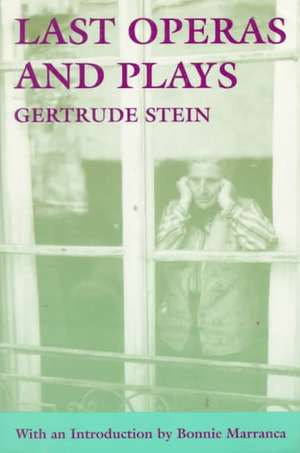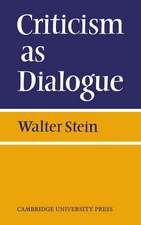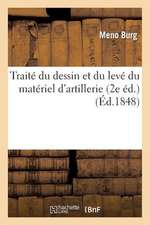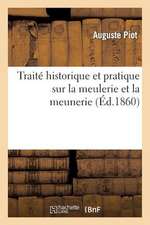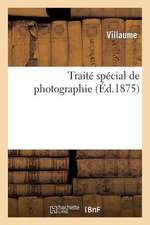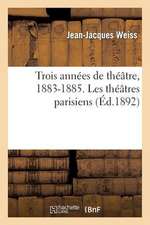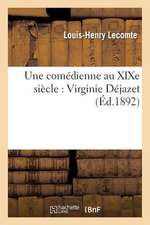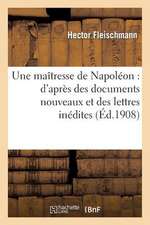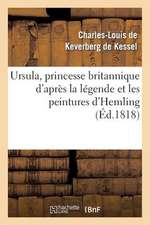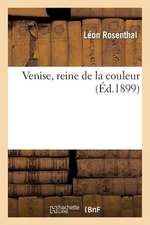Last Operas and Plays: PAJ Books
Autor Steinen Limba Engleză Paperback – 21 mai 1995
In the more than seventy-five plats Gertrude Stein wrote between 1913 and 1946, she envisioned a new dramaturgy, beginning with her pictorial conception of a play as a landscape. She drew into her plays the daily flow of life around her--including the natural world--and turned cities, villages, parts of the dramatic structure, and even her own friends into characters. She made punctuation and typography part of her compositional style and chose words for their joyful impact as sound andwordplay. For Strin, the writing process itself was always important in delevoping the continuous present at the heart of her work.
Long out of print, Last Opera and Plays again makes available many of Stein's most important and most-produced works. As a special feature, it also included her thought-provoking essay Plays, in which she reflects on the experience in the theater of seeing and hearing, and on emotion and time. Now nearly a half century after her deathe, writes Bonnie Marranca in her introduction, it is indisputable that Gertrude Stein is the great American modernist mind. No American author has been more influential for more generations of artists in the worlds of theater, dance, music, poetry, painting, and fiction.
Preț: 287.11 lei
Nou
Puncte Express: 431
Preț estimativ în valută:
54.94€ • 57.67$ • 45.60£
54.94€ • 57.67$ • 45.60£
Carte disponibilă
Livrare economică 21 martie-04 aprilie
Livrare express 06-12 martie pentru 41.95 lei
Preluare comenzi: 021 569.72.76
Specificații
ISBN-13: 9780801849855
ISBN-10: 0801849853
Pagini: 536
Ilustrații: black & white illustrations
Dimensiuni: 142 x 217 x 32 mm
Greutate: 0.61 kg
Ediția:Revised
Editura: Johns Hopkins University Press
Seria PAJ Books
Locul publicării:Baltimore, United States
ISBN-10: 0801849853
Pagini: 536
Ilustrații: black & white illustrations
Dimensiuni: 142 x 217 x 32 mm
Greutate: 0.61 kg
Ediția:Revised
Editura: Johns Hopkins University Press
Seria PAJ Books
Locul publicării:Baltimore, United States
Notă biografică
Gertrude Stein (1874 - 1946) was an American novelist, poet, playwright and art collector. Born in the Allegheny West neighborhood of Pittsburgh, Pennsylvania and raised in Oakland, California, Stein moved to Paris in 1903 and made France her home for the remainder of her life. She hosted a Paris salon, where the leading figures of modernism in literature and art, such as Pablo Picasso, Ernest Hemingway, F. Scott Fitzgerald, Sinclair Lewis, Ezra Pound, Sherwood Anderson and Henri Matisse, would meet. In 1933, Stein published a quasi-memoir of her Paris years, The Autobiography of Alice B. Toklas, written in the voice of Alice B. Toklas, her life partner and an American-born member of the Parisian avant-garde. The book became a literary bestseller and vaulted Stein from the relative obscurity of the cult-literature scene into the limelight of mainstream attention. Two quotes from her works have become widely known: "Rose is a rose is a rose is a rose" and "there is no there there", with the latter often taken to be a reference to her childhood home of Oakland, California. Her books include Q.E.D. (Quod Erat Demonstrandum) (1903), about a lesbian romantic affair involving several of Stein's female friends, Fernhurst, a fictional story about a romantic affair, Three Lives (1905-06) and The Making of Americans (1902-1911). In Tender Buttons (1914), Stein commented on lesbian sexuality. Her activities during World War II have been the subject of analysis and commentary. As a Jew living in Nazi-occupied France, Stein may have only been able to sustain her lifestyle as an art collector and indeed to ensure her physical safety, through the protection of the powerful Vichy government official and Nazi collaborator Bernard Faÿ. After the war ended, Stein expressed admiration for another Nazi collaborator, Vichy leader Marshal Pétain.
Descriere
This volume contains a collection of Stein's works. It also includes her essay "Plays", in which she reflects on the experience in the theatre of seeing and hearing, and on emotion and time. She envisioned a new dramaturgy, beginning with the pictorial conception of a play as a landscape.
